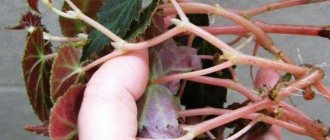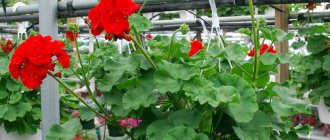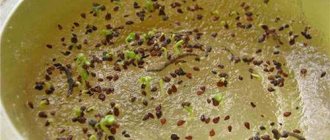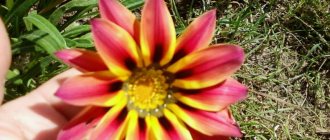Begonias are tropical plants. There are decorative deciduous and beautifully flowering representatives. In the summer they can be planted in open ground, or take the pot out onto the veranda or balcony. All types of begonias bloom actively throughout the warm season, and in the fall, when the days get shorter and the radiators work in houses, the plants experience discomfort. In this article we will tell you how to preserve begonia in the winter at home so that in the spring it will delight you with abundant flowering.
Winter care for tuberous species 1.1. Digging up tubers 1.2. How to properly store tubers in winter 2. Caring for plants with roots in the cold season 2.1. How to care for everblooming plants in winter
Photo by O. Nikonorova: Begonia blooms in the cold season and requires the attention of the gardener.
Due to lack of lighting, flowers stretch out, and due to lack of moisture in the air, leaves dry out. That is why the plant needs a special approach during the cold season.
Features of winter care
In the first year, begonia tubers are small and weak. Therefore, they require special care. There is a risk of death of young rhizomes if they are left in storage with adult specimens.
- Young plants are removed from the beds in the fall and placed together with a ball of soil in boxes with a peat mixture. For first-year begonias, the state of rest is relative. In winter, their upper part remains green. Containers with flowers are placed in a bright and cool place. It is recommended to moisten the soil once every 2 months.
- In adult flowers, the lower part dies off by autumn. It is cut off, the roots are dug up, and placed in boxes with sawdust, peat or sand. Planting rhizomes are kept in a cool place until spring in the refrigerator or in the basement.
It is not recommended to store tubers in the cellar due to high humidity . This has a very negative effect on plants.
Begonia in pots
If the plant bloomed all summer in containers on the balcony or in the garden, they do not need to be replanted or removed from this container in the fall. It is enough to move the pots from the street to the basement or leave them on a glassed-in loggia, but place them in a dark place. The temperature should be about +10 degrees.
The tubers can also be stored in the refrigerator. To do this, you must follow all the rules for digging up the roots and then place them in a plastic bag filled with sand or peat. Do not close the package to avoid rotting.
Rest period and awakening
Dormancy or wintering for tuberous begonias begins in November and continues until early March. The florist must take care of the planting material: preserve it and prevent it from drying out. To do this, certain rules are followed:
- Begonias should not be retired at the beginning of autumn. To prepare for wintering, they must gain enough nutrients.
- Tubers need to be dug up at the end of October - beginning of November (before the onset of serious frosts).
At the end of March - beginning of April, the buds sprout and the begonia awakens. This is the right time to take cuttings and plant a plant:
- 2 months before planting, the tubers are removed from the container in which they overwintered and placed in a container for germination.
- The roots are planted with the crown up.
- The tubers are germinated in a room with a temperature of at least +18 degrees.
- Water daily. Sprouts will appear within a few weeks.
- Before planting, you can separate the tubers. There must be buds on each half. The cut areas are sprinkled with coal powder.
- Sprouted begonias are placed on the beds no earlier than the beginning of June. Choose a place well protected from direct sunlight and wind.
Useful tips
To ensure proper wintering for perennials, you should follow several recommendations:
- do not plant begonia before the end of the dormant period, which usually lasts until the beginning of March;
- break off the sprouts that appear on root crops before spring;
- when sprouts form in winter, move the boxes with tubers to a cooler place;
- sprouted tubers in the refrigerator - sort out, dry well and wrap each specimen in paper;
- Be sure to germinate the bulbs before planting;
- Plant garden begonias in the ground only after the appropriate air temperature has become stable.
Proper maintenance of begonia with the provision of the necessary conditions in winter is a guarantee of active development and abundant flowering of the perennial throughout the next season.
The difference between wintering at home and in the open ground
Caring for tubers in garden and house plants is different. In order to properly prepare them for wintering, their characteristic features are taken into account.
Rules for handling begonias growing outdoors:
- Flowers are removed from the garden plot with the arrival of the first hard frost. There is no need to rush to dig during light frosts - begonias tolerate short-term drops in temperature.
- When the plant's stems and leaves dry out, they are cut off.
- The tubers are removed from the ground, placed in a box and placed to dry.
- The container with planting material is placed in storage until spring.
Indoor begonias are treated differently:
- Their tubers do not need to be dug up - the plants are in their pots.
- The stems are trimmed as soon as they begin to wilt.
- Watering is reduced to a minimum.
- The flower is transferred to a cool place.
- To prevent the soil from drying out completely, it is periodically moistened.
In spring, the tubers are transplanted into fresh substrate . If many buds appear, they are divided into several fragments.
Sometimes indoor begonia remains green all winter. The flower is left in its place until spring, then replanted.
We recommend that you read our other articles about planting rules and subsequent care for begonias:
- tuberous;
- ampelous;
- Bolivian.
Where to start caring for begonias in the fall
The plant blooms all summer and with the arrival of cold weather it fades, the above-ground part gradually dies off and prepares to rest. This distinguishes tuberous begonia from evergreen begonia, which grows in flowerpots at home. It does not have roots; instead, it has tubers that grow in width. This allows you to easily grow begonia not only in flower beds in summer, but also in pots and wide small flowerpots on terraces.
With the arrival of autumn, the flower is watered less and less, preparing for winter rest. All the gardener needs to do is wait until the above-ground part gradually withers and dies. In September, rare watering is carried out.
In indoor tuberous begonias, the stems and leaves die off by mid-October. In the garden - with the arrival of cold weather. At this time, the plant needs to be trimmed, leaving 1-2 cm from the root.
Is it necessary to dig it up?
In order for the garden crop to survive the winter, the tubers are dug up only when severe frosts occur.
Autumn is an important stage in the life of begonias . During this period, it must stock up on nutrients, grow tubers, and form flowering buds.
When answering the question “should you dig up begonia for the winter,” its condition and type are taken into account:
- Large outdoor tubers are removed from the ground after wilting.
- Large roots of home grown crops are left in their place for the winter.
- Flowers with small nodules and sprouted from seeds are dug up and placed in a cool, well-lit place.
The gardener should not rush to send outdoor plants to winter at the first slight frost. But you can’t delay it either.
Wintering first-year begonias
Storage of first-year plants obtained from seeds is different because their dormant period is relative. Their aboveground part does not die off in the fall, and they must overwinter in pots.
Since small tubers retain their leaves, they need light. But the temperature should not exceed 15 degrees. First-year plants are watered moderately to avoid rotting.
Inexperienced gardeners mistakenly treat young nodules in the same way as large, mature ones. But this cannot be done, because first-year plants grown from seeds continue to grow in winter. If stored incorrectly, they will dry out.
Preparing a tuberous plant for storage until spring
Begonias growing in the garden are dug up before the onset of heavy frost . The foliage on them will finally fly off, and the stems will dry out.
It is recommended to remove the tubers from the ground with a pitchfork. The earth is not shaken off from the roots.
Features of preparing plants for winter:
- The tubers are dried in a cool, dry place.
- Placed in special containers: boxes or paper bags.
Store planting material until spring at a temperature of +7-9 degrees.
The wintering features of indoor begonia are different:
- It is prepared for rest in October.
- Reduce moisturizing and stop completely after a month.
- The top of the flower is cut off after wilting. If it does not dry out, leave it as is.
How to water a flower
In winter, watering begonias should be minimal.
Improper watering is the only problem that can cause a begonia to die or behave capriciously. Begonia is not a very capricious plant, but caring for it requires following certain rules.
The main ones are:
- High soil moisture. At the same time, water should not be allowed to linger in the pot or be in the pan. The root of the plant is located in such a way that it is not able to take water from the pan, so keeping it there is useless and can lead to rotting of the root.
- Drying of the soil. The plant needs daily watering with settled water, the temperature of which should be close to room temperature. If you are going on vacation or on a business trip for a long time, make sure that there will be someone to care for your plant.
In summer, begonias need to be watered abundantly throughout the day. An hour after watering, be sure to drain excess water from the pan. If the weather is not too hot and in the spring-autumn period, watering the begonia 2-3 times a week is enough. In this case, it is advisable to water at the same time.
In winter, the plant must be fed and prepared for flowering. Watering should be minimal, because the plant is dormant. With the beginning of spring, the plant wakes up, so the amount of watering must be increased. It is best to water it with soft water (cooled boiled).
Flowering indoor begonia
How and when does Begonia bloom?
Amazing beauty pleases the eye when begonia blooms brightly and abundantly enough . Its luxurious flowers resemble buds of a rose, carnation or peony. They are simple and double , large and small , collected in racemose axillary inflorescences formed at the tips of the shoots. The perianth consists of 2-5, and in some species - 6-8 petals. The color scheme varies from white, yellow, pink, red to all sorts of transitional shades, two-tone with a border of flowers, providing a unique holiday atmosphere around you.
The many faces of elegant buds decorate your room from early June until September or from late spring to late autumn, depending on proper care.
Flowering period
The stage of active growth and flowering of the plant requires feeding at least once a week with complex mineral fertilizer. In this case, first a weak solution of potassium nitrate is added, and then everything else.
Begonia dormant period
At the end of flowering, the plant is prepared for the resting phase, gradually reducing the amount of watering until its above-ground part finally dries out. We remove everything that has dried , put the pot in a cool place, watering it occasionally. The temperature should not be higher than 10-12 degrees. The dormant period will last from November to March.
Begonia scent
Among the variety of plant varieties, there are both odorless and fragrant (Bauman's begonia).
Its smell is unique and even has medicinal properties . The invisible influence of begonia helps cleanse the bronchi, increases the vitality of the respiratory tract, and in itself is an excellent natural filter for people with nicotine addiction.
Decorative foliage plants
Decorative deciduous varieties of begonias do not have a clearly defined dormant period. They can grow equally well in winter and summer.
But due to the fact that daylight hours decrease in winter, natural light becomes insufficient for these plants.
Therefore, with intensive watering, they develop incorrectly, stretch out and become thinner.
In order for decorative deciduous begonia to grow more slowly in winter, its temperature is reduced and watering is reduced. In winter, such varieties are kept at a temperature of about 16ºC and watered only when the top layer of soil in the pot dries out.
In winter, it is undesirable to keep decorative deciduous begonia at room temperature , since at high temperatures (22-26ºC) frequent watering of the plant is necessary.
To prevent the plant from stretching out when watering frequently, you need to provide it with good lighting. But since even on southern windows in winter there is not enough light for begonias, you will have to organize additional electric lighting for at least 6 hours a day.
Peculiarities
If begonia is kept at low temperatures in winter, it must be watered very sparingly. The top layer of soil must dry out to a depth of at least 3 cm between waterings, otherwise the roots of the plant will rot very quickly.
Excessive humidity at low temperatures leads to fungal diseases of these flowers.
When keeping decorative deciduous begonia in a heated room, it needs to be watered more often than during a cool winter, but much less often than in the summer.
The surface of the soil should dry out between waterings . You need to place the flower on the most illuminated windowsill. Direct sun in winter will not harm the plant.
Begonia should not be placed near heating radiators. The air near heating appliances becomes very dry in winter, and this is harmful to the plant. With low humidity, the leaves may begin to dry out.
To prevent this from happening, you should move the begonia to a windowsill away from radiators and take care to humidify the air in the room. You cannot spray the flower so that water gets on the leaves; it is enough to spray the moisture near the plant.
The disturbed root system of the plant recovers very slowly in winter and is susceptible to disease. Cuttings for rooting are not cut in winter, since at this time they slowly take root and often rot.
How to welcome spring?
At the beginning of March, plants wake up from winter hibernation.
The tubers should be removed and left in a warm room for a while to warm them up.- Then treat the tubers with a solution of potassium permanganate.
- Before planting in the ground, it is advisable to germinate in damp sawdust or sand.
- If a medium-sized tuber has buds, it can be divided into several parts.
- Treat the sections with ash.
- When spring night frosts are no longer dangerous, tuberous begonia is planted in open ground.
- In the first days of spring, indoor plants are moved to the brightest windowsill in the house.
- Little by little they begin to resume the irrigation regime, gradually increasing the ambient temperature.
- Before the active growth phase begins, the plant can change the soil. It’s easy to find out whether a flower needs this: the root system has filled the entire space of the pot. Begonia should be replanted into a pot with a diameter larger than the previous one, doing this carefully and carefully. There must be a drainage layer at the bottom of the container.
- In the spring, they begin to gradually feed the flowers. This is especially true for non-transplanted plants.
- The soil in which they are located should be enriched with mineral fertilizers.
Watch a video about the awakening of tuberous begonias in the spring:
How does begonia bloom?
What to do after the begonia has bloomed?
After the plant has pleased you with lush flowering, you should definitely dry . We put it in a dark place for a month so that all the nutrients from the stems and roots go into the tuber. We dig it out 15 days after the upper part of the begonia, which is on the surface, has finally died off.
Do I need to prune begonias after flowering?
After completing the flowering stage, the plant needs pruning. At the same time, cut off the stems . This is necessary so that the flower gains strength and nutrients and has the opportunity to thank its owner in the future with a magnificent and fragrant bouquet of double begonia inflorescences.
Cold season care for different species
Tuberous flowers are grown in open ground and in flowerpots on windowsills , and below we will look at how they can be preserved. This type of begonia has a pronounced sleep period, but garden and indoor plants overwinter under different conditions.
Garden
At the end of November, the tubers of the plant are carefully dug out from open ground.- Cut the stems, leaving no more than 2cm. Shake off the remaining soil and send it to dry in a warm, dry, ventilated room.
- After 10-14 days, the dried tubers are placed in a pre-prepared box for further storage. The optimal temperature and humidity conditions for normal conservation of natural material will be up to +10°C and humidity 80%.
- The tubers are located in a natural substrate, sand or peat, which is recommended to be moistened periodically.
Indoor
If tuberous begonia grows on windowsills, it is not removed from flowerpots for the winter . In order for the plant to gain strength and energy for further development, it is necessary to provide suitable conditions:
- Move to a dimly lit area in the house.
- Reduce temperature to +15°C.
- Water once every 10 days.
- Maintain humidity 60-70%.
- Do not apply fertilizers.
- Do not replant or propagate plants.
- If the leaves and stems do not wither over the winter, there is no need to prune the begonia.
- Insulate the begonia pot so that the root system of the flower does not get too cold.











